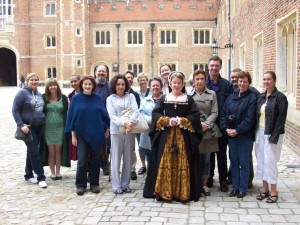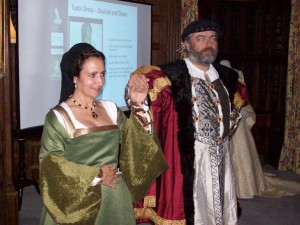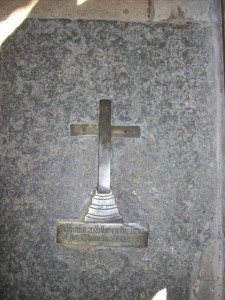 I’m so sorry that this post is so late but we stayed up rather late on Thursday night chatting into the night and then Tim and I were travelling on Friday.
I’m so sorry that this post is so late but we stayed up rather late on Thursday night chatting into the night and then Tim and I were travelling on Friday.
On Thursday, we took the group to Hampton Court Palace, the beautiful palace which Henry VIII nabbed off Cardinal Wolsey. We took a tour, complete with audio guides, of the Tudor kitchens while our guide, Siobhan, got changed into her Tudor costume. Goodbye Siobhan, hello Lady Margaret Douglas! Siobhan really did look the part and we thoroughly enjoyed the private guided tour she gave us of the Tudor parts of the palace – the Great Hall, the Watching Chamber, the Haunted Gallery and all the wonderful portraits. We also enjoyed the beautiful and tranquil Chapel Royal.
In the Great Hall, Siobhan pointed out the remaining HA in the woodwork but eagle-eyed Emma, with her rather posh camera (ok, Tim, you might get one for Christmas if you’re very good!), found another on the ceiling – HR and AR. What a find! Those of us who chose Siobhan’s tour (rather than free time) in the afternoon saw the gardens, a game of Royal Tennis, a hidden staircase used by Henry VIII and a Victorian reproduction of Wolsey’s Closet, which is haunted by a little white dog. Unfortunately, I had forgotten to book the ghosts so Jane Seymour, Catherine Howard and the little white dog just did not turn up!
Although much of Henry’s palace, such as his presence chamber, Anne Boleyn’s lodgings etc. no longer exist, we were able to imagine how the palace would have looked in Henry’s reign. Anne Boleyn helped Henry plan the work for the palace so it had Anne’s stamp on it too.
 We then headed off back to Hever where we had another wonderful meal followed by a talk by expert Tudor costumer, Bess Chilver, who, this time, bought along her husband Edmund to show us how Tudor noblemen dressed. Before our eyes, Edmund and Maryam (one of our attendees) became a Tudor couple and Bess gave a fascinating talk about the different parts of Tudor clothing and who was allowed to wear what. Thanks so much, Bess and Edmund!
We then headed off back to Hever where we had another wonderful meal followed by a talk by expert Tudor costumer, Bess Chilver, who, this time, bought along her husband Edmund to show us how Tudor noblemen dressed. Before our eyes, Edmund and Maryam (one of our attendees) became a Tudor couple and Bess gave a fascinating talk about the different parts of Tudor clothing and who was allowed to wear what. Thanks so much, Bess and Edmund!
Some of us then stayed up socialising and chatting about our favourite parts of the tour and Friday morning came around all too fast. What was great was that we had time to enjoy the gardens before the coach pick up at 10am and Tim and I kept coming across people strolling round with happy smiles on their faces or rather dream-like looks. We were sad to leave but I think we all felt fulfilled. Hever had worked its magic on us! There were then lots of hugs and thank yous as the coach departed. I’d just like to say at this point that I miss the group already. They were all fantastic and real friendships were made – I love you guys!
After the final farewell (sob!), Tim and I visited the Church of St John the Baptist at Penshurst. Tour attendees, Clare and David, joined us as they were off to Penshurst Place for the day, and both Clare and I have done extensive research into the Boleyn family and were keen to pay our respects to little Thomas Boleyn, brother of Anne Boleyn, just as we had done at St Peter’s in Hever to little Henry Boleyn and Anne’s father, Thomas. Thomas Boleyn Junior lies in the Sidney Chapel in the Church and his resting place is marked by a simple brass cross and an inscription which reads “Thomas Bullayen the son of Sir Thomas Bullayen”. It is a tiny tomb, just like the infant one of Henry Boleyn’s at St Peter’s, and it’s simplicity is in stark contrast to the surrounding Sidney family tombs.

A couple of people have asked me about this tomb as they have read that Alison Weir is claiming that Thomas Boleyn Junior died in 1520 as an adult and some have even suggested that his tomb is marked 1520. While the church’s information leaflet says that he died in 1520, the tomb is that of an infant – in that it is the typical simple cross and is tiny – and bears no date. Clare even blew up her photos of the tomb to see if a date had been faintly inscribed somewhere and there is no date. Clare also checked Parish records but these only go back to 1558. I will be contacting the church to see if they have any records supporting the 1520 date given in the leaflet but I wonder if it’s a typo. If 1520 is correct then it’s a bit of a conundrum – if Thomas Boleyn died as an adult why isn’t there more mention of him in the records and an infant Boleyn child dying in 1520 just does not fit with Elizabeth Boleyn’s age – she was born around 1480.
Hmmm…
Anyway, until it is proved otherwise I stand by my opinion that Thomas Boleyn Junior died in infancy. The tomb is that of a child.